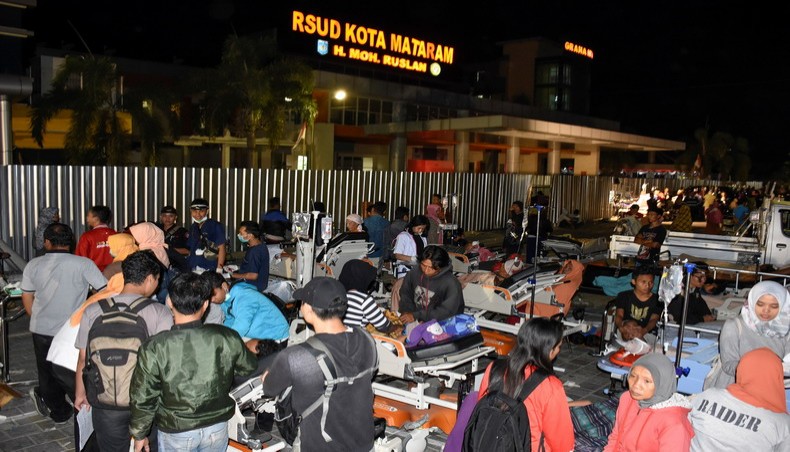Mataram: Indonesia evacuated hundreds of tourists from popular resorts and sent rescuers fanning across the holiday island of Lombok after a powerful quake killed at least 91 people and reduced thousands of buildings to rubble.
The shallow 6.9-magnitude quake sparked terror among tourists and locals alike, coming just a week after another deadly tremor surged through Lombok, killing at least 17 people.
Rescuers on Monday searched for survivors in the rubble of houses, mosques and schools that were destroyed in the latest disaster which struck Sunday evening.
“91 people died, 209 suffered from serious injuries,” national disaster agency spokesman Sutopo Purwo Nugroho said.
“There are challenges: the roads were damaged, three bridges were also damaged, some locations are difficult to reach and we don’t have enough personnel.” An operation was also under way Monday to evacuate some 1,200 tourists from the Gili Islands, three tiny, coral-fringed tropical islands a few kilometres off the northwest coast of Lombok that are particularly popular with backpackers and divers.
Local disaster officials said 358 tourists had been evacuated so far. At least one person, an Indonesian holidaymaker, was killed on the Gili islands while another tourist died on nearby Bali, which is a major destination.
Denink Ayu, a hotel receptionist on Gili Trawangan, the biggest of the three Gilis, told CNN Indonesia that “everybody was panicking” after the quake hit.
“We are fighting for boats now. We are all queuing at the port, but there is not enough boats,” she said tearfully.
But it was Lombok which bore the brunt of Sunday evening’s quake.
The shallow tremor sent thousands of Lombok residents and tourists scrambling outdoors, where many spent the night as strong aftershocks including one of 5.3-magnitude continued to rattle the island.
The quake knocked out power in many areas, and parts of Lombok remained without electricity Monday.
Nugroho said up to 20,000 people may have been evacuated from their homes on Lombok and that paramedics, food and medication were badly needed.
Hundreds of bloodied and bandaged victims were treated outside damaged hospitals in the main city of Mataram and other hard-hit parts of the island.
Patients lay on beds under makeshift wards sent up in tents, surrounded by drip stands and monitors, as doctors in blue scrubs attended to them.
“Many injured people are being treated outside of hospitals and health clinics because the buildings were damaged,” Nugroho said.
Upset relatives were huddled around loved ones in front of the main clinic in Mataram, as medical staff struggled to cope with hundreds of patients, many of whom were yet to be seen despite spending the night out in the open.
“What we really need now are paramedics, we are short-staffed, we also need medications,” Supriadi, a spokesman for Mataram general hospital, said.
Outside the hospital, the rubble-strewn streets of Mataram were empty, save for a few survivors picking nervously through the ruins.
Most of the victims were in the mountainous north and east of the island, away from the main tourist spots and coastal districts in the south and west.
Najmul Akhyar, the head of North Lombok district, estimated that 80 percent of that region was damaged by the quake.
“We need heavy equipment because some mosques have collapsed and we suspect some worshippers are still trapped inside,” he told Metro TV.
As authorities scrambled to assess the extent of damage in Lombok, some tourists were trying to leave.
“We tried to go to the airport but there was no taxi, no transport, no plan for evacuation,” French tourist Jina told Metro TV.
“Later I stopped a car and I asked a local please take me and my family to the airport and he said ”okay no problem’.” Singapore’s Home Affairs Minister K. Shanmugam, who was in Lombok for a security conference when the earthquake struck, described on Facebook how his hotel room on the 10th floor shook violently.
“Walls cracked, it was quite impossible to stand up,” he said.
Bali’s international airport suffered damage to its terminal but the runway was unaffected and operations had returned to normal, disaster agency officials said. Lombok airport was also operating.
Indonesia, one of the most disaster-prone nations on earth, straddles the so-called Pacific “Ring of Fire”, where tectonic plates collide and many of the world’s volcanic eruptions and earthquakes occur.
In 2014, a devastating tsunami triggered by a magnitude 9.3 undersea earthquake off the coast of Sumatra in western Indonesia killed 220,000 people in countries around the Indian Ocean, including 168,000 in Indonesia.
Agencies
